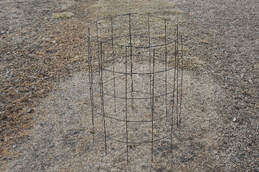
Count off 13 squares but cut each horizontal wire at the end of the 13 square. This will leave a series of 12 complete squares horizontally with prongs left on the 13th square. Use these prongs to make a cylinder by bending the prongs over the vertical wire on the first square. Tomatoes with large, rangy vines need all five feet of the mesh, but those with shorter, semi-determinate vines can get by with a shorter cage.
Also, cut off the bottom horizontal wire to leave prongs that can be pushed into the ground to help with stability. As mentioned above, a T-post will likely need to be driven near the cage. Tying the cage to the T-post can help prevent the cage from toppling in windy conditions.
These cages will last for years, but do take up a great deal of storage space when not in use. If you don’t have room for storage, there are heavy-duty tomato cages that will either fold flat or disassemble to make storage easier such as Texas Tomato Cages, Titan Tomato Cages and various others. Regardless, they may need to be staked if your garden is in a windy location. (Ward Upham)
 RSS Feed
RSS Feed
